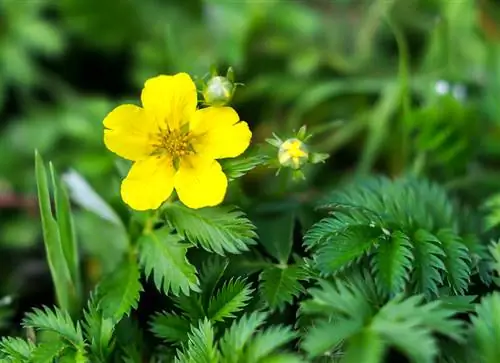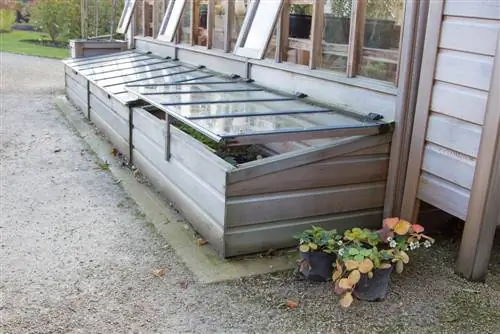- Author admin [email protected].
- Public 2023-12-25 17:45.
- Last modified 2025-01-23 11:22.
The diverse cinquefoil genus, with 500 species, invites us to make the most of it. How you can professionally cultivate the robust perennials in the rock garden, cottage garden, the perennial bed or on the edge of the wood is no longer hidden from you. The following answers to frequently asked questions show how to do it right.

What should you consider when caring for cinquefoil?
Cinquefoil is a robust perennial that, depending on the species, grows in rock gardens, cottage gardens or on the edge of trees. Care includes occasional watering and fertilizing, pruning after flowering and, if necessary, a change of location in autumn or spring. The perennial is non-toxic and hardy.
Planting cinquefoil correctly
You can plant crab herbs grown in containers all year round. As long as the ground is not frozen or there is a summer drought, the perennials gain a foothold in the bed. The best time for planting is in autumn, during the months of September and October. Prepare the soil loosely and free of weeds to suit the type and variety you choose. Soil that is too sandy is enriched with compost, while soil that is too nutrient-rich is emaciated with sand. Although the choice of location and soil preparation depend on the species and variety, planting follows this pattern:
- Place the potted young plant with the root ball in water until no more air bubbles appear
- Dig a planting pit with 1.5 times the volume of the root ball
- Plant the potted cinquefoil so deeply that the previous planting depth is retained
Press the soil with your hands without compacting it too much and water.
Care tips
You will have to use the lantern to find a perennial that requires less care than cinquefoil. We have put together the few measures for skilful care for you here:
- Watering and fertilizing only required in persistent drought or for noble varieties
- Pruning after flowering allows hybrids to bloom a second time in autumn
- Winter protection is not necessary
The prerequisite for this mini-care program is a careful choice of location that is tailored as precisely as possible to the selected species and variety. For example, if you plant a swamp cinquefoil in the gravel bed and a white cinquefoil at the edge of the pond, any care effort will be in vain.read more
Which location is suitable?
Within up to 500 species, the indestructible genus of crabworts gifts us with perennials for almost every location. As long as there is no Egyptian darkness at the chosen location, you will find what you are looking for. The following selection lists the requirements of proven classics:
- White cinquefoil (Potentilla alba): Sunny, lime-free, stony and well-drained
- Swamp cinquefoil (Potentilla palustris): Sunny to partially shaded, swampy and humus
- Red cinquefoil (Potentilla atrosanguinea): sunny to partially shaded, loamy to sandy and fresh and moist
- Golden cinquefoil (Potentilla aurea): Sunny in any normal garden soil
Don't forget the creeping cinquefoil (Potentilla reptans), which, as a ruderal pioneer, likes to settle in the garden uninvited and is often fought as a weed.read more
When is flowering time?
The numerous genus of cinquefoils contains decorative species with divergent flowering times. Cleverly combined, a flowering perennial can be found in the garden throughout the entire growing season. The following selection may serve as your inspiration:
- Golden cinquefoil (Potentilla crantzii): April to June; Hybrids with rebloom in August
- Large-flowered cinquefoil (Potentilla megalantha): May to July; Hybrids with rebloom in September
- Garden cinquefoil (Potentilla x cultorum): July to August; Hybrids with rebloom in October
- Swamp cinquefoil (Potentilla palustris): July to September
In order to encourage a cinquefoil to bloom again, pruning close to the ground is essential. Alternatively, regularly clean out wilted flowers with your fingers.
Cut cinquefoil correctly
Cut the perennial back close to the ground after flowering to prevent the energy-sapping seed growth and prevent unwanted self-seeding. With hybrids you will be rewarded for these efforts with autumnal re-blooming. This is a touch sparser than the main flower. With a portion of compost after cutting, you can stimulate new growth.read more
Watering cinquefoil
Watering pure cinquefoil species is only necessary in exceptional cases. As a rule, natural rainfall covers the water requirement. If the drought persists during the summer, you won't pass the thirsty plant with the watering can without pampering it with a drink of water. The richly flowering noble hybrids, on the other hand, are always watered when the soil on the surface has dried out.
Fertilize cinquefoil properly
If you cultivate one of the magnificent hybrids in the perennial bed, the growth and abundance of flowers benefit from repeated fertilizer application. At the start of the season and after the first pruning, add a portion of compost (€10.00 on Amazon), horn shavings, bark humus or guano granules to the root disc. Pure species, on the other hand, do not require additional nutrient intake. If deficiency symptoms appear, such as pale colors and stunted growth, an organic fertilizer will give the perennial new vitality.
Wintering
Winter protection is a foreign concept for cinquefoil species and varieties. The perennials can easily cope with bitter cold temperatures down to -28.8 degrees Celsius. Early flowering specimens do not let even a blanket of snow stop them from stretching their first leaves and flowers towards the sun.
Propagate cinquefoil
If you have discovered other corners in the garden that should be planted with cinquefoil, nothing stands in the way of easy propagation. The following procedures have proven successful in hobby gardens for generations:
- Dividing the root ball in spring or autumn
- Cut non-flowering cuttings during the summer and let them root in the pot
- Cut off the runners, cut into 5-8 cm long pieces and plant in the lean substrate until roots form
Sowing is also mentioned here, but compared to the methods mentioned, it stands out negatively due to the greater amount of work involved. In addition, cinquefoils propagated from seedlings usually only bloom after a few years.
How do I transplant correctly?
If you tell the perennial to change location, the cinquefoil will calmly accept the associated stress. Please choose a date in autumn or spring. Loosen the root ball with the digging fork and then lift it out of the ground with the spade. A spacious planting pit should already be prepared at the new location so that the cinquefoil can be planted at exactly the same depth as before. In the following period, regular watering promotes rapid rooting.
Is cinquefoil poisonous?
Cinquefoil is completely free of toxic ingredients. On the contrary, plant parts of creeping cinquefoil are used in folk medicine. You can also use the sour-tasting leaves to enhance salads and other dishes.read more
Beautiful varieties
- Goldrausch: Dainty variety that adorns thin cracks in walls or the rock garden with golden yellow flowers; Growth height 10-15 cm
- Hopwoodiana: Pink flowering variety jewel for the perennial bed with delicately lobed leaves; Growth height 30-40 cm
- Arc-en-Ciel: Fantastically beautiful double cinquefoil with carmine-red flowers edged in yellow; Growth height 40-45 cm
- Roxana: Large-flowered cinquefoil that shows off its salmon-red flowers from July to August; Growth height 40-50 cm
- Alba: White-flowering cinquefoil, a beautiful ground cover for lime-free, stony locations; Growth height 10-15 cm






